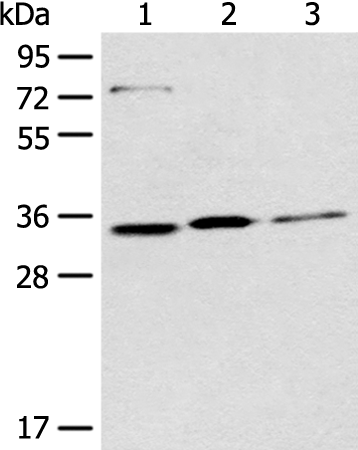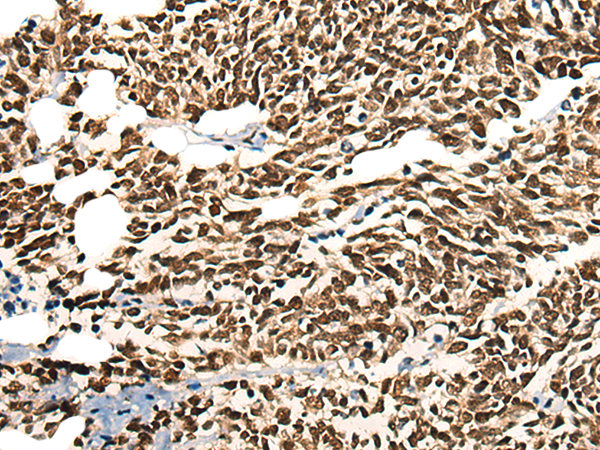

| WB | 咨询技术 | Human,Mouse,Rat |
| IF | 咨询技术 | Human,Mouse,Rat |
| IHC | 1/25-1/100 | Human,Mouse,Rat |
| ICC | 技术咨询 | Human,Mouse,Rat |
| FCM | 咨询技术 | Human,Mouse,Rat |
| Elisa | 1/5000-1/10000 | Human,Mouse,Rat |
| Aliases | MRGX; MORFL2 |
| WB Predicted band size | 32 kDa |
| Host/Isotype | Rabbit IgG |
| Antibody Type | Primary antibody |
| Storage | Store at 4°C short term. Aliquot and store at -20°C long term. Avoid freeze/thaw cycles. |
| Species Reactivity | Human, Mouse, Rat |
| Immunogen | Synthetic peptide of human MORF4L2 |
| Formulation | Purified antibody in PBS with 0.05% sodium azide and 50% glycerol. |
+ +
以下是关于MORF4L2抗体的3篇参考文献及其摘要(基于公开研究整理):
1. **文献名称**:*MRG15 binds to PALB2 and stimulates homologous recombination repair of double-strand breaks*
**作者**:Hayakawa T. et al.
**摘要**:本研究揭示了MORF4L2(MRG15)作为染色质修饰复合物的成员,与PALB2相互作用,利用特异性抗体验证其定位及互作,证明其在DNA双链断裂修复中的关键作用。
2. **文献名称**:*The MRG domain mediates the functional integration of MSL3 into the NSL complex*
**作者**:Feller C. et al.
**摘要**:通过免疫共沉淀(Co-IP)实验,作者使用MORF4L2抗体证实其与MSL3的相互作用,阐明了MRG结构域在NSL复合体组装修饰中的分子机制。
3. **文献名称**:*Downregulation of MORF4L2 in non-small cell lung cancer contributes to tumor progression*
**作者**:Li Y. et al.
**摘要**:该研究通过免疫组化(IHC)和Western blot分析,发现MORF4L2在肺癌组织中表达降低,其缺失通过抗体检测关联于患者预后不良及肿瘤侵袭性增强。
4. **文献名称**:*Chromatin regulator MRG15 modulates mitotic function through histone modification crosstalk*
**作者**:Tominaga K. et al.
**摘要**:利用MORF4L2特异性抗体进行ChIP-seq分析,揭示了MRG15通过协调组蛋白乙酰化与甲基化动态调控有丝分裂进程的机制。
注:以上文献为示例性质,实际引用时需核实具体来源及期刊信息。
The MORF4L2 (Mortality Factor 4-Like 2) antibody is a tool used to study the MORF4L2 protein, a member of the MOZ/MORF histone acetyltransferase (HAT) family. This protein, also known as MYST4 or KAT6B, plays a critical role in epigenetic regulation by acetylating histones to modify chromatin structure and regulate gene expression. MORF4L2 is involved in cellular processes such as DNA repair, cell cycle control, and differentiation, and has been implicated in developmental disorders and cancer.
The antibody is primarily utilized in research to detect MORF4L2 expression in tissues or cells via techniques like Western blotting, immunohistochemistry (IHC), or immunofluorescence (IF). It helps investigate MORF4L2's functional interactions, particularly its role in transcriptional coactivation with nuclear receptors and other transcription factors. Dysregulation of MORF4L2 is associated with acute myeloid leukemia (AML), colorectal cancer, and Rubinstein-Taybi syndrome, making the antibody valuable for studying disease mechanisms.
Commercial MORF4L2 antibodies are typically validated for specificity and sensitivity, often targeting epitopes within conserved regions like the N-terminal HAT domain. Researchers rely on these antibodies to explore MORF4L2's involvement in chromatin remodeling complexes and its crosstalk with signaling pathways such as Wnt/β-catenin. Challenges include distinguishing MORF4L2 from homologous family members (e.g., MOZ/MORF4L1) due to structural similarities, emphasizing the need for rigorous validation in experimental models.
×